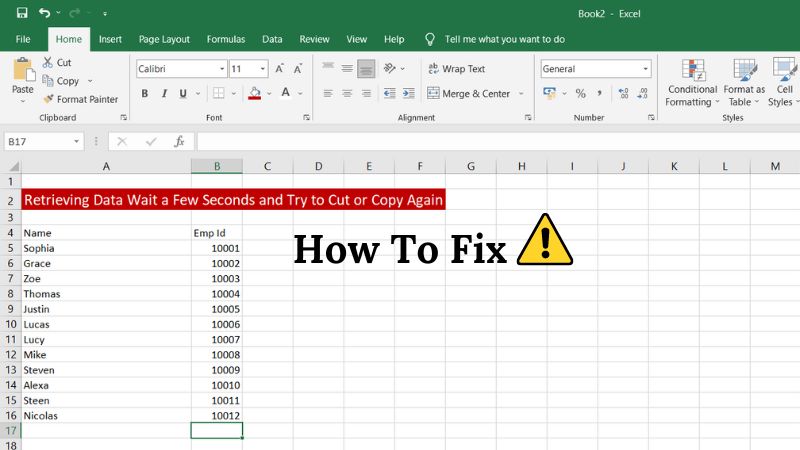Transporting items by car may seem straightforward, but there are many nuances to ensuring both your safety and the safety of others on the road. From securing your cargo to managing unforeseen issues, preparation is key. In this guide, we’ll explore six simple steps to transport items safely by car while addressing a common troubleshooting concern: “Retrieving Data. Wait a Few Seconds and Try to Cut or Copy Again.: Troubleshooting Guide 2025.”
Table of Contents
ToggleStep 1: Plan Your Journey Thoroughly
Before loading your car, it’s essential to plan your journey in detail. Start by assessing the best route to your destination, taking into account road conditions, traffic, and weather. If you’re carrying fragile or heavy items, opt for roads that are less bumpy or crowded.
Understanding your destination also helps you gauge how secure your items need to be. For example, if you’re traveling over long distances, ensure you have stops planned for rechecking your cargo. Using GPS apps, you can minimize delays and avoid areas under construction. These small preparations prevent unnecessary risks and reduce the chances of encountering the error: “Retrieving Data. Wait a Few Seconds and Try to Cut or Copy Again.: Troubleshooting Guide 2025.”
When planning your trip, make a checklist of necessary items such as tie-downs, blankets for fragile goods, and other tools. This ensures you’re ready to address issues on the go. Such readiness is vital to avoiding common mishaps.
Have a question or feedback? Connect with us in the comments below or reach out to our team for personalized assistance on LookMyFinance.
Step 2: Select the Right Vehicle
Choosing the appropriate vehicle for transporting items is critical. A compact car may suffice for light loads, but larger or more complex items often require a truck or van. Overloading your vehicle can lead to accidents, decreased fuel efficiency, and increased wear and tear on your car.
Check your vehicle’s load capacity and consult your owner’s manual for guidance. Misjudging your car’s limits could lead to unnecessary stress, much like encountering the persistent error: “Retrieving Data. Wait a Few Seconds and Try to Cut or Copy Again.: Troubleshooting Guide 2025.”
Consider using a vehicle with a flatbed or a trailer for particularly heavy or oversized cargo. These provide more space and flexibility while ensuring the load remains stable. Additionally, check the condition of your tires and brakes before starting your journey—safety always begins with a well-maintained vehicle.
Step 3: Secure Your Cargo Properly
Properly securing your cargo is a step you cannot afford to skip. Unsecured items can shift or fall, leading to accidents or damage. Begin by assessing the nature of your load. Are you transporting fragile items, loose tools, or bulky furniture? Tailor your approach based on the cargo’s specifics.
Use ratchet straps, bungee cords, or ropes to fasten items securely. For smaller items, consider using bins or boxes to consolidate them. Additionally, padding materials such as blankets or foam can prevent damage during transit. This level of care ensures you avoid scenarios where you’re metaphorically stuck with “Retrieving Data. Wait a Few Seconds and Try to Cut or Copy Again.: Troubleshooting Guide 2025.”
Once secured, test the stability of your cargo by gently pushing or pulling on it before you hit the road. A little effort upfront can save you a lot of trouble later, as unsecured loads are one of the leading causes of road accidents involving transported goods.
Step 4: Drive Cautiously and Adaptively
Driving safely becomes even more critical when transporting goods. Accelerate and brake gradually to prevent sudden shifts in the cargo. Maintaining a safe distance from other vehicles gives you extra reaction time, which is essential when your car is carrying additional weight.
Stay within the speed limit and avoid abrupt lane changes. These maneuvers can destabilize your load, leading to potential mishaps. Remember, encountering an unexpected issue on the road can feel as frustrating as seeing “Retrieving Data. Wait a Few Seconds and Try to Cut or Copy Again.: Troubleshooting Guide 2025” pop up repeatedly.
Make use of tools like blind-spot mirrors or backup cameras if your cargo obstructs your rearview. These aids enhance your visibility, making it easier to navigate safely. In challenging conditions such as rain or fog, exercise extra caution by reducing your speed and increasing your following distance.
Step 5: Monitor and Adjust During the Trip
Even with meticulous preparation, it’s vital to monitor your cargo throughout the journey. Schedule periodic stops to check that everything remains securely fastened. Tighten straps or reposition items as necessary to prevent shifting.
If you notice unusual noises or changes in how your car handles, investigate immediately. Overlooking minor signs can escalate into significant problems. Think of this step as addressing the equivalent of “Retrieving Data. Wait a Few Seconds and Try to Cut or Copy Again.: Troubleshooting Guide 2025—proactive checks prevent compounding errors.
Use rest stops not only to check your cargo but also to stretch and reset your focus. Fatigue is a common cause of accidents, and maintaining your energy levels ensures you stay alert and responsive.
Step 6: Unload Safely and Efficiently
Upon reaching your destination, unloading your cargo with care is just as important as securing it. Assess the unloading area for hazards such as uneven surfaces or obstacles. Approach the task methodically, especially if heavy lifting is involved.
Use proper lifting techniques to avoid injuries, and consider asking for help with cumbersome items. If you’re unloading fragile goods, double-check their condition before removing them from the vehicle. Taking your time during this final step prevents mishaps and ensures your efforts don’t end with frustration, much like resolving “Retrieving Data. Wait a Few Seconds and Try to Cut or Copy Again.: Troubleshooting Guide 2025” after numerous attempts.
Once your items are safely unloaded, conduct a quick inspection of your vehicle for any damage or residue left behind. Keeping your car clean and maintained ensures it’s ready for future tasks.
FAQs
- What does “Retrieving Data. Wait a Few Seconds and Try to Cut or Copy Again.” mean in a car troubleshooting context? This message might indicate a temporary delay in retrieving information from a system or device, such as GPS or onboard diagnostics, and suggests retrying the action shortly.
- How do I fix the “Retrieving Data. Wait a Few Seconds and Try to Cut or Copy Again.” error in my vehicle’s infotainment system? Restart the system, check for software updates, or ensure proper connections for devices integrated with the infotainment system.
- Can “Retrieving Data. Wait a Few Seconds and Try to Cut or Copy Again.” appear due to poor network connectivity? Yes, in systems relying on internet access, weak or unstable connectivity can cause this error.
- Why does my GPS show “Retrieving Data. Wait a Few Seconds and Try to Cut or Copy Again.” while navigating? This may occur due to outdated maps, weak signal reception, or internal software glitches in your GPS.
- How does “Retrieving Data. Wait a Few Seconds and Try to Cut or Copy Again.” relate to vehicle diagnostics? It can indicate a delay in fetching diagnostic codes or live data from your vehicle’s onboard computer.
- What steps should I take if “Retrieving Data. Wait a Few Seconds and Try to Cut or Copy Again.” keeps recurring on my car’s system? Perform a hard reset, update the system firmware, or consult the user manual for troubleshooting tips.
- Is “Retrieving Data. Wait a Few Seconds and Try to Cut or Copy Again.” a common issue in modern cars? Yes, with advanced systems, minor delays in retrieving or processing data can result in such messages.
- Does “Retrieving Data. Wait a Few Seconds and Try to Cut or Copy Again.” indicate a hardware problem? Not necessarily; it’s often related to software or connectivity but can occasionally point to hardware issues.
- How can I avoid “Retrieving Data. Wait a Few Seconds and Try to Cut or Copy Again.” errors during long drives? Keep your systems updated, ensure strong network connections, and minimize unnecessary multitasking on integrated devices.
- Does “Retrieving Data. Wait a Few Seconds and Try to Cut or Copy Again.” affect system performance? It might temporarily delay certain operations, but it typically doesn’t have long-term effects on performance.
- Can external devices cause “Retrieving Data. Wait a Few Seconds and Try to Cut or Copy Again.”? Yes, improperly connected or incompatible devices can trigger this error message.
- Why does my phone show “Retrieving Data. Wait a Few Seconds and Try to Cut or Copy Again.” when connected to my car? This can result from sync issues between your phone and the car’s system, especially during data transfer.
- What role does memory capacity play in “Retrieving Data. Wait a Few Seconds and Try to Cut or Copy Again.” errors? Insufficient memory or processing power in older systems can slow data retrieval, causing such messages.
- Can outdated software updates lead to “Retrieving Data. Wait a Few Seconds and Try to Cut or Copy Again.”? Yes, outdated firmware or software may struggle to process new data, resulting in this error.
- How do I troubleshoot “Retrieving Data. Wait a Few Seconds and Try to Cut or Copy Again.” on third-party devices? Restart the device, ensure proper connections, and check for compatibility with your car’s system.
- Does the message “Retrieving Data. Wait a Few Seconds and Try to Cut or Copy Again.” signal data corruption? Not typically, but it could hint at temporary file access issues or minor corruption.
- Why do I see “Retrieving Data. Wait a Few Seconds and Try to Cut or Copy Again.” during voice command use? Delayed data processing or insufficient network access for cloud-based voice recognition can cause this.
- Is “Retrieving Data. Wait a Few Seconds and Try to Cut or Copy Again.” related to my vehicle’s internet subscription? Yes, vehicles requiring internet access may display this message if the subscription is expired or inactive.
- Can clearing cache resolve “Retrieving Data. Wait a Few Seconds and Try to Cut or Copy Again.” in car systems? Clearing cached data can improve system performance and resolve temporary retrieval issues.
- How can professional servicing help with “Retrieving Data. Wait a Few Seconds and Try to Cut or Copy Again.”? Technicians can diagnose and resolve underlying software or hardware issues that may cause this message.
Table: Quick Reference for Safe Transportation
| Step | Key Actions |
|---|---|
| Plan Your Journey | Assess routes, check weather, prepare tools, and create a checklist. |
| Select the Right Vehicle | Choose appropriate vehicle, verify load capacity, and ensure maintenance. |
| Secure Your Cargo | Use straps, boxes, and padding; test stability before driving. |
| Drive Cautiously | Avoid abrupt maneuvers, maintain safe speed, and use aids like mirrors and cameras. |
| Monitor During Trip | Schedule stops to check cargo, tighten straps, and address unusual noises or handling issues. |
| Unload Safely | Assess hazards, use proper lifting techniques, and inspect vehicle post-unloading. |
Final Thoughts
Transporting items by car requires more than simply loading and driving off. By following these six steps, you can ensure the safety of your cargo, your vehicle, and yourself. From planning and preparation to monitoring and unloading, every step contributes to a smooth and stress-free experience.
And remember, whether you’re tackling a persistent tech issue like “Retrieving Data. Wait a Few Seconds and Try to Cut or Copy Again.: Troubleshooting Guide 2025” or navigating the challenges of cargo transport, patience and attention to detail are your best tools for success.






